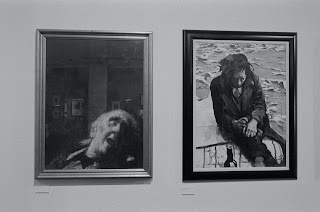A friend of mine decided he needed to sell a few cameras to thin out his collection and one of them was a Minolta Dynax 4 fitted with a Minolta 28-80mm f/3.5-5.6 kit lens. He listed it on ebay with three other cameras that were attracting bids, but nobody was interested in the Minolta. I figured I would help him out and started the bidding at £10.
A few days later, it was the only bid and I was the new owner of this very clean camera and lens. To be fair he wasn't expecting much interest in it and was glad it sold to someone he knew would use it. He duly despatched it to me and a couple of days later it arrived. Knowing how well my friend cares for his cameras I wasn't surprised at the condition. It looks like new and the lens is clear and free from dust. I purchased some batteries for it and set about learning how to use it.
The Minolta Dynax 4, called the Maxxum 4 in the Americas and the Dynax 3 in the Asia Pacific region, was introduced in 2002 and was on sale until 2004. I soon discovered that this light weight, plastic, auto focus camera was listed at the top of the lower entry level, aimed at beginners who want an easy to use SLR with enough features to help them hone their skills over time. It was also at a price that wouldn't be beyond reasonable reach of most people.
It's the kind of camera that you can carry around all day every day with no effort and capture photos good enough to hang on the wall using full auto, the various scene modes or fully manually. The standard Minolta 28-80mm zoom, sold as a kit lens with the camera, is not the fastest zoom lens, but certainly a solid performer and capable of producing excellent photos.
I learned it is very similar in operation as the Minolta Dynax 500si I bought for my grandson a couple of years back and does everything that camera can do. Shutter speeds are from 30 seconds to 1/2000th of a second with bulb mode and a self timer. It has scene modes for portrait, landscape, macro, sport and night photography. A film DX code reader is built in and if you want a little more creative control the iso can be manually selected ranging from 6 - 6400. There's also a built in flash too. I loaded a roll of Agfaphoto APX400 35mm B&W film and headed out for a wander to try it out.
That wander turned out to be indoors at Salford Museum and Art Gallery on a day out with my wife and our pal Keith who came to visit. The good folks at Salford Museum and Art Gallery were great to let me and Keith loose with our cameras. Their conditions were "No Flash" and we had to sign an agreement not to sell any of our photos. We said we would send them some photos and signed on the dotted line.
I upped the iso to 800, set the camera to aperture priority and took a
deep breath, I knew I might have to breathe like a sniper for this one. I was glad I upped the iso to 800 as it gave me enough shutter speed to keep camera shake at bay without having to shoot wide open all day long. Even the couple of photos I took in the dimly lit Lark Hill Place street exhibit were well exposed. My entry level Minolta Dynax 4 with its kit lens performed admirably and I managed to shoot an entire roll as we wandered around Salford Museum and Art Gallery.
I developed my roll of APX400 shot at 800 iso a couple of days later with Kodak HC110 dilution B for 11 1/2 minutes at 20 celcius. and soon had it hanging to dry in my bathroom. I digitised it the next day with my Nikon D700, Tamron Adaptall 2 90mm f/2,5 macro lens, Valoi 35mm film holder, Pixl-Latr and A5 size led light pad. I processed the raw files with Affinity Photo 2.
I have to say I am rather impressed with how well my photos came out. The Minolta Dynax 4 was on the market at the end of the glory days of film and was discontinued after 3 short years. The inevitable move to digital by all the big players saw them discontinue all film camera production by 2006 which left only disposable and simple plastic cameras left in production to the present day.
If you want to learn film photography, you can pick up a Minolta Dynax 4 and it will feel instantly familiar to those who have been using DSLR and Mirrorless digital cameras. It has all the famiiar functions and presets that were designed in the 80's and are on all modern cameras today. They are also in the class of "Plastic, Auto Focus" film cameras that dont get a lot of love and consequently are dirt cheap to buy. Mine was £10 well spent.
Here's a few favourites from our day at Salford Museum and Art Gallery. if you want to see them for yourself in all their colourful glory, the museum is open all year round and it's free to get in. Donations are of course welcomed and there's a café for drinks and snacks if you like to have a break during your visit. More information about Salford Museum and Art Gallery is available via their website using the link below.
Salford Museum and Art Gallery





.jpg)



.jpg)


No comments:
Post a Comment